We may receive a commission when you use our affiliate links. However, this does not impact our recommendations.
 In the day of helicopter parents, litigious lawyers and cubicle life how is a person going to experiment with a risk vs. reward model with relative safety? Woodworking gives us an outlet to analyze, and take the risks that can provide great reward while avoiding the risks don’t.
In the day of helicopter parents, litigious lawyers and cubicle life how is a person going to experiment with a risk vs. reward model with relative safety? Woodworking gives us an outlet to analyze, and take the risks that can provide great reward while avoiding the risks don’t.
One example is pushing a board through a saw. It doesn’t matter what type of saw you’re using, if you push the board through in an unsafe manner there is risk of losing limbs or digits. Yes, you may have to performed that action 100,000 times safely but the risk still isn’t worth it. Analyze the situation, determine the risk vs. reward and take action. You should cut the wood using a push stick, or any other safety tool to reduce the risk to acceptable levels but still get the work done.
Now, let’s examine dovetails. One of the hardest things I do when teaching new woodworkers, especially teens, is convincing them that they have the ability to cut to the line. Invariably they’ll analyze the situation themselves and decide, “I’ll just cut a little off and chisel back.” But, there is just as much chance they’ll butcher the work chiseling. You can’t put the wood back in once it is chiseled out.
By observing others and gaining a bit of experience they’ll reanalyze the risk vs. the potential rewards and eventually try to ‘split the line.’ They realize they are cutting straight, they’re just not cutting on the actual line. By hitting the line, they see that they are doing less work in the end. They risk that one tail maybe being loose but they’ll have 3 others to get right so likely the joint will work anyway…there just may be a few gaps.
Woodturners strive not to sand. Many times this demands taking risks. Some will hover on the edge of a catch in order to get the smoothest cut with the least tear out. The potential reward is not having to sand at all. But the risk is a nasty catch, losing hours of work and potentially harming yourself.
I take a personal assessment every time I cut an end grain shoulder with my skew. You make this cut with the very tip of your skew but you have to lean the edge in to make a clean cut. The closer the cutting wedge is to touching the wood, the better the tip will sever end grain fibers. The smoother the shoulder, the crisper the edge and cleaner the line. Sandpaper would only worsen the result. But if the wedge touches the wood…game over.
So every time, I make an internal and external assessment. I think about how my body is working. Is the temperature outside causing my hands to be less dexterous? Is my normal overdose of caffeine causing my hands to shake? Are my thoughts elsewhere? Is the piece internally unbalanced causing vibration? All these thoughts determine how close to the edge of disaster I am and how high the quality of my cut will be.
Time and time again these types of situations pop up in skilled craft. Your understanding of the situation and your own abilities determines your success. The more experienced you get, the grayer situations can become. Nuances arise and more variables are utilized. You have the opportunity to get better at decision making through practice.
Now imagine the potential of a kid who’s thought process and analysis is completely ingrained from repetition. Or an adult who exercises that part of their brain as if they were training it for a marathon. Professional, personal and societal behaviors would be affected.
Long story short…learn and stay in a craft your whole life. And if you can, bring along a kid. We’ll all benefit in the end.
Personally I’d like the next generation to be better decision makers than my own.
Do you have any other examples of nuanced decision making you do in your woodworking?
Here are some supplies and tools we find essential in our everyday work around the shop. We may receive a commission from sales referred by our links; however, we have carefully selected these products for their usefulness and quality.








Funny that knowing when to quit has become the early leader here. I would say the same goes with me when woodturning. Chunk the edge of a bowl… stop, sharpen, reshape the edge, bang another catch. I should have just walked away and come back the next day to it instead. Now, when that sort of thing happens I clean up and leave the project for another day and instead sharpen everything in the shop that needs it. Hopefully, I’ll prevent some other screw up in the future this way.
I agree that it would be nice to bring a young one along into the woodworking world. There is a lot to be learned
from the process of making something. These lessons apply apply to life also. Success and failure, may not be black and white, but can be modified to something acceptable.
Knowing when to quit is something I had to learn the hard way. I was working full time at my job, electronics industry, while I was making a Bar for a Friend’s bistro. I was pushing to finish on time and tried to make a cut that I should have jigged-up. Long story short, the table saw bit me. Thank goodness it wasn’t really bad, I do have crooked finger now. 🙂
Bravo! You have described the essence of craft. Practice and the willful intention of doing something well is at the heart of craft and, I believe, any artistic endeavor. Woodworking is distinguished by artisanship over the artistic due to the needed facility with the physical processes whereas artistry is bound up in the metaphysical and is much harder to teach. Artisanry is the solution. Artistry is the precipitate.
The one thing it took me a long time to learn was when to quit. When I started woodworking again (after a very long hiatus), I was still working full time with long commutes. I re-started woodworking by entering classes at night, after work. It took me nearly a year to realize that most of my errors and goofs were occurring as the evening was winding down. I made a conscious decision to choose a time to stop all activities, especially cutting, that could produce a significant error in the work. I was OK to sand parts, mark future cuts (which would be reviewed before the actual cuts were made), or plan out the next sessions task list; but, I remained steadfast in my refusal to cut. My errors and goofs dropped off dramatically. Basically, I guess I’m saying is that I needed to recognize when I’d reached my physical limit of productivity, much like skiers who seem to get hurt on the last run of the day.